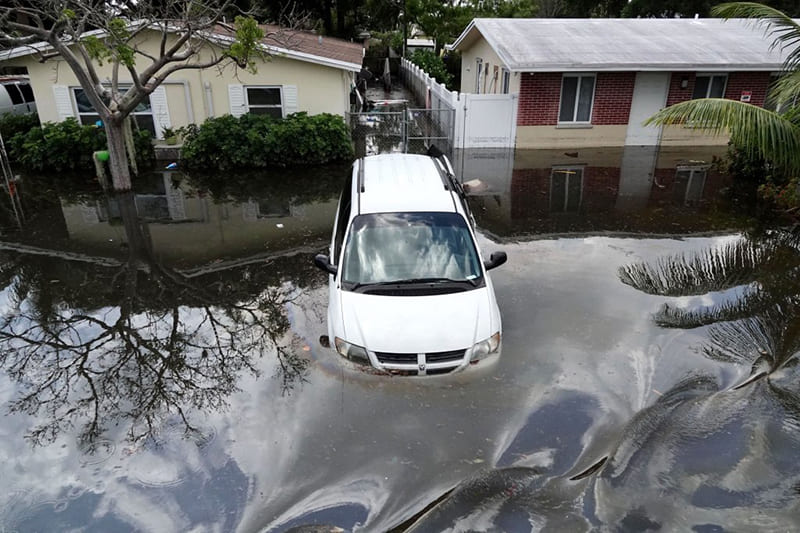Home insurance costs in Florida are unlikely to fall even as reforms enacted by the state Legislature last year drive down litigation rates, a national insurance analyst predicted in a newly released report.
The report by Karen Clark & Company, titled “Managing Expectations: Why Florida Homeowners Insurance Premiums Are Not Likely to Go Down,” says rising inflation rates, reinsurance costs and effects of climate change will keep insurance losses — and rates — climbing as litigation costs taper off.
Karen Clark & Company provides catastrophe risk assessments with models that cover hurricanes, earthquakes, severe convective storms, wildfires and floods in more than 50 countries. The company’s models are used by global reinsurers, insurers and investors.
Litigation has been identified as a significant cost driver in Florida and contributed to “significantly inflated” losses in the state over the past several years, the report said. For example, the percentage of litigated claims from Hurricanes Irma and Michael have been 10 times higher than those from storms that did not hit Florida, including Laura and Ida. Those higher rates made claims from Irma and Michael 30% to 50% higher than they would have been without the excess litigation, the report found.
A series of reforms enacted in 2022 by the Florida Legislature sought to preserve the state’s private insurance market by making it more costly to sue insurance companies. The reforms included eliminating the ability to assign insurance benefits to third parties, such as contractors and eliminating attorneys’ ability to obtain legal fees from insurers when settling claims for as little as $1 over insurers’ original offers.
But litigation, the report said, is the only major insurance rate factor that can be reduced by lawmakers. And while legislation reducing litigation may eventually prevent higher rate increases, the other factors “will continue to influence future home homeowner premiums, and it is unlikely these costs will go down,” the report said.
Those factors are:
Hurricanes: Four hurricanes with maximum wind speeds of 150 mph or greater made landfall in the United States over the past five years, including two in Florida (Michael and Ian). Three consecutive storms of that intensity hit the U.S. over three consecutive years for the first time in the historical record. Michael and Ian caused severe damage that would have been far greater if those storms had made landfall near Tampa or Miami, the report said.
Scientific consensus that hurricane severity is increasing due to global climate change, according to the report, points to increased risk to Florida homeowners and steeper losses for insurers.
Non-hurricane catastrophes: The report documents an increase in severe convective storms that are typically accompanied by damaging tornadoes, hail and high wind gusts. The number of such events in Florida increased each of the past five years, from 15 in 2019 to 42 in 2023, through the end of September. Losses have increased over the same period from $347 million in 2019 to $925 million so far in 2023.
Sea-surface temperature increases in the Gulf of Mexico are contributing to a shift in severe convective storm activity from the Midwest region known as Tornado Alley to the Southeast region called Dixie Alley that includes eastern Texas and Arkansas, Louisiana, Mississippi, Tennessee, Alabama, Georgia, western Kentucky and Western North Carolina and upstate South Carolina.
“This means higher hail, tornado, and straightline wind losses in Florida than have been observed historically,” the report said.
Inflation and rising construction costs: Home repair and replacement costs have risen by double digits recently thanks to material and labor shortages, and the average cost of construction in Florida has jumped nearly 40% since 2017, the report said. “Even if insurance rates don’t increase,” it said, “homeowners premiums will increase due to the rising costs of construction.”
Reinsurance supply and cost: Florida insurance companies are heavily dependent on reinsurance and factor reinsurance costs into premiums charged to policyholders, the report said.
Over the past couple years, reinsurers have restricted coverage and increased prices, the report said. Reinsurers base their prices on “their own risk appetites and what the market will bear” and not on catastrophe models, it said, adding that recent reinsurance price increases of 50% to 100% “were clearly not indicated by the models.”
CEOs from leading reinsurers recently warned insurers in catastrophe-prone areas that future increases should be expected, the report said.
Insurance experts consulted for this story concurred with its conclusions.
Paul Handerhan, president of the Federal Association for Insurance Reform, said he agrees that “while litigation frequency is trending down, the macroeconomic and weather drivers referenced in the Clark report are eclipsing any rate benefits consumers would have experienced from the legislative reforms.”
Mark Friedlander, communications director for the industry-funded Insurance Information Institute, said by email that “while we are hopeful that legislative reform will eventually bring stability to the Florida market and stop the surge of insolvencies that we say last year, we do not currently see a path to lower average rates for consumers.”
Friedlander cited increases in reinsurance costs and home replacement costs, citing an III analysis that found home replacement costs increased a cumulative 55% between 2019 and 2022.
On a positive note, Friedlander said, “five new insurers being approved to write in Florida, combined with depopulation of (state-owned) Citizens (Property Insurance Corp.) are steps in the right direction.”
More choices for consumers “will hopefully lead to more competitive pricing,” he said. “However, that doesn’t necessarily mean lower average rates.”
Stabilizing the market should bring “moderate” annual rate increases to Florida, in line with this year’s 10% to 12% national average, compared to the 33% and 42% hikes that the organization tracked in Florida over the past two years.

